 Photo by PaDIL |
Karnal bunt (Tilletia indica)
- Hosts are wheat, durum and triticale
- Parts of seeds are blackened and crush relatively easily
- Infected grain has a distinct fishy smell
- If it became established in Australia, access to over 45 international markets would be restricted and grain price would be significantly reduced
Fact sheet |
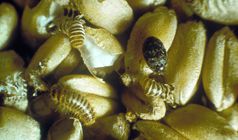 Photo by Ministry of Agriculture and regional Development Archive, Ministry of Agriculture and Regional Development, Hungary, Bugwood.org |
Khapra beetle (Trogoderma granarium)
- Adults are small (2-3 mm long) and do not fly
- Spread in infested grain
- Larvae are hairy and can survive for over a year without food
- Phosphine fumigation gives poor control
- If established, it would affect market access
Fact sheet |
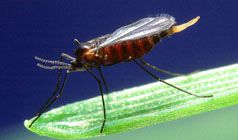 Photo by Scott Bauer, USDA Agricultural Research Service, Bugwood.org |
Hessian fly and Barley stem gall midge (Mayetiola destructor and M. hordei)
- Adults are small (2-4 mm long) and look like mosquitos
- Pupae have a ‘flaxseed’ appearance
- Attack leaves, stems and heads of cereals
- Most chemical controls are not effective
- Cereal crop losses up to 40% could occur
Fact sheet |
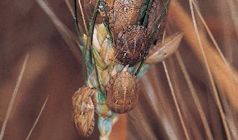 Photo by ICARDA |
Sunn pest (Eurygaster integriceps)
- Brown bug with wide oval-shaped body (12 mm long) with a wide triangular head
- Attacks most cereal crops
- Colonies can be seen on cereal heads in spring
- Injects enzymes into the plant as it feeds which can result in grain damage and abortion
Fact sheet |
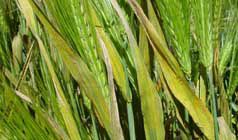 Photo by PaDIL |
Barley stripe rust (Puccinia striiformis f. sp. hordei)
- Would infect barley in all Australian growing regions
- Approximately 80% of Australia’s barley varieties would be susceptible
- Yellow stripes of fungal spores produced between veins of leaves
- Can be spread by wind and rain, or on clothing, machinery and tools
- Any stripe rust on barley should be reported
Fact sheet |
 Photo by University of Georgia Plant Pathology Archive, Bugwood.org |
Wheat stem rust, pathotype Ug99 (Puccinia graminis f. sp. tritici)
- Pathotype identified in Uganda in 1999 that has overcome several stem rust resistance genes
- Many Australian wheat varieties will be susceptible
- Elliptical blisters produced on stems, which break open to reveal a mass of rust coloured spores
- Stem rust on known resistant varieties should be reported
Fact sheet |
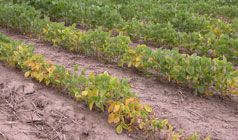 Photo by CR Grau, University of Wisconsin-Madison |
Soybean cyst nematode (Heterodera glycines)
- Considered most damaging pathogen of soybean worldwide.
- Affects the roots, resulting in patchy growth, poor tillering and stunting of plants.
- Spreads rapidly. Female nematodes contain eggs that remain viable for up to 10 years without a host.
Fact sheet |
Additional high priority pests for Western Australia
The following pests are established in other parts of Australia, but not present in Western Australia. |
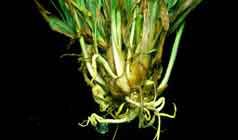 Photo by S Taylor |
Stem nematode (Ditylenchus dipsaci)
- Not present in WA
- Oat race hosts are oat, faba bean, and wild oat. Also recorded on field pea, canola, lentil and chickpea seedlings
- Symptoms include poor emergence and establishment, stunting and distortion of plants, swollen stem bases, premature plant death, lodging, fewer seed heads
- Spread by infested hay, straw and other plant material, in soil by movement of machinery and as a contaminant of seed
Fact sheet |
 Photo by K Lindbeck, NSW I&I |
Lentil anthracnose (Colletotrichum truncatum)
- The lentil strain of this pathogen has not been recorded in WA
- Symptoms include white to greyish lesions on stems, branches and petioles
- Lesions may contain small black fruiting bodies and turn brown as plants mature
- Low rate of seed transmission
- Spread by movement in lentil trash and infected dust from harvesting lentils
Fact sheet |
 Photo by Alton N Sparks Jr, University of Georgia, Bugwood.org |
Sorghum midge (Stenodiplosis sorghicola)
- Recorded in eastern Australia and Northern Territory but not WA
- Occurs in tropical and sub-tropical areas
- Attacks grain and forage sorghum, Johnson and Columbus grasses
- Transport of grain containing larvae into WA is restricted
|
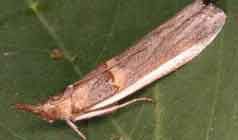 Photo by Gyorgy Csoka, Hungary Forest Research Institute, Bugwood.org |
Lima bean pod borer (Etielia zinckenella)
- Has been found in Queensland where it attacks legume crops
- A threat to lupin and pulse crops in WA
- Yield losses due to infestation can be high
- Damaged seed is down-graded and cannot be used for seed
- Once inside legume pods, control is very difficult
|
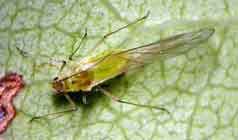 |
Rose – grain aphid (Metopolophium dirhodum)
- A common aphid in cereals in south-eastern states of Australia
- Large green aphids that may have a dark green stripe down the middle of the back
- Tend to colonise leaves higher on the plant
- Feeding damage can occur on stem, leaves and heads in tillering and later stages of crop growth
- Can spread barley yellow dwarf virus
|
 The following are some key high priority exotic pest threats for the Australian grains industry as identified through the development of the Industry Biosecurity Plan for the Grains Industry. Any of these pests would have serious consequences should they enter and become established in Australia.
The following are some key high priority exotic pest threats for the Australian grains industry as identified through the development of the Industry Biosecurity Plan for the Grains Industry. Any of these pests would have serious consequences should they enter and become established in Australia.
















Recent Comments